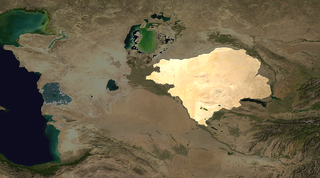
The Kyzylkum Desert is the 15th largest desert in the world. Its name means Red Sand in Turkic languages. It is located in Central Asia, in the land between the confluent rivers Amu Darya and Syr Darya, a region historically known as Transoxania. Today it is divided among Kazakhstan, Turkmenistan and Uzbekistan. It covers about 298,000 km2 (115,000 sq mi).

The sika deer, also known as the Northernspotted deer or the Japanese deer, is a species of deer native to much of East Asia and introduced to other parts of the world. Previously found from northern Vietnam in the south to the Russian Far East in the north, it is an uncommon species that has been extirpated in most areas of its native range, except in Japan, where it is overabundant and present in very large numbers.
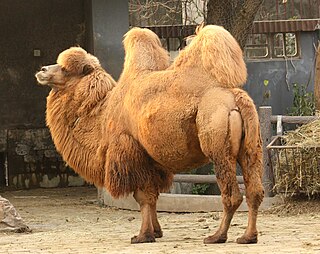
The Bactrian camel, also known as the Mongolian camel, domestic Bactrian camel or two-humped camel, is a large even-toed ungulate native to the steppes of Central Asia. It has two humps on its back, in contrast to the single-humped dromedary. Its population of 2 million exists mainly in the domesticated form. Their name comes from the ancient historical region of Bactria.
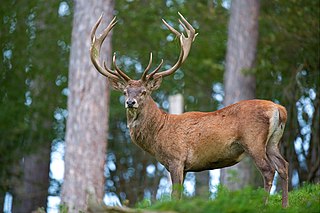
The red deer is one of the largest deer species. A male red deer is called a stag or hart, and a female is called a doe or hind. The red deer inhabits most of Europe, the Caucasus Mountains region, Anatolia, Iran, and parts of western Asia. It also inhabits the Atlas Mountains of Northern Africa; being the only living species of deer to inhabit Africa. Red deer have been introduced to other areas, including Australia, New Zealand, the United States, Canada, Peru, Uruguay, Chile and Argentina. In many parts of the world, the meat (venison) from red deer is used as a food source.

The Caspian tiger was a Panthera tigris tigris population native to eastern Turkey, northern Iran, Mesopotamia, the Caucasus around the Caspian Sea, Central Asia to northern Afghanistan and the Xinjiang region in western China. Until the Middle Ages, it was also present in southern Russia. It inhabited sparse forests and riverine corridors in this region until the 1970s. This population was regarded as a distinct subspecies and assessed as extinct in 2003.

Thorold's deer is a threatened species of deer found in grassland, shrubland, and forest at high altitudes in the eastern Tibetan Plateau. It is also known as the white-lipped deer for the white patches around its muzzle.
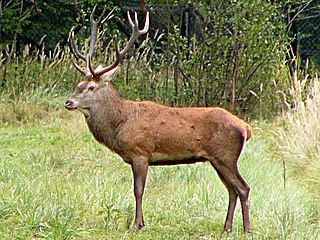
Cervus is a genus of deer that primarily are native to Eurasia, although one species occurs in northern Africa and another in North America. In addition to the species presently placed in this genus, it has included a whole range of other species now commonly placed in other genera. Additionally, the species-level taxonomy is in a state of flux.
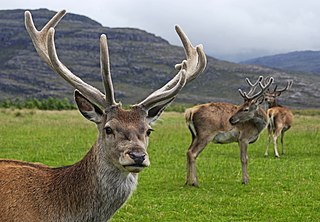
The Scottish red deer is a subspecies of red deer, which is native to Great Britain. Like the red deer of Ireland, it migrated from continental Europe sometime in the Stone Age. The Scottish red deer is farmed for meat, antlers and hides.
The Yarkand deer, also known as the Theenivs deer, Tarim deer, or Lop Nor stag, is a subspecies of the Central Asian red deer that is native to the province of Xinjiang, China. It is similar in ecology to the related Bactrian deer in occupying lowland riparian corridors surrounded by deserts. Both populations are isolated from one another by the Tian Shan Mountains and probably form a primordial subgroup of the Central Asian red deer.

The Tibetan red deer also known as shou, is a subspecies of elk/wapiti native to the southern Tibetan highlands and Bhutan. Once believed to be near-extinct, its population has increased to over 8,300, the majority of which live in a 120,000-hectare nature reserve established in 1993 in Riwoqê County, Qamdo Prefecture, Tibet Autonomous Region, China. Some have been kept at the beginning of the 20th century in London, and in a small zoo south of Lhasa.
The Sichuan deer, also known as MacNeill's deer, is a subspecies of the Elk native to Western China.

The Manchurian wapiti is a subspecies of the wapiti native to East Asia.
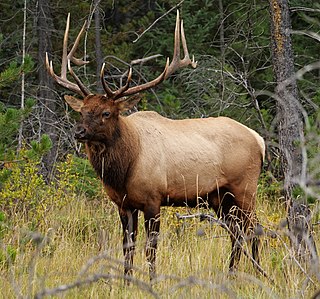
The elk, or wapiti, is the second largest species within the deer family, Cervidae, and one of the largest terrestrial mammals in its native range of North America and Central and East Asia. The word "elk" originally referred to the European variety of the moose, Alces alces, but was transferred to Cervus canadensis by North American colonists. The name "wapiti" derives from a Shawnee and Cree word meaning "white rump" for the distinctive light fur in the rear region, just like the Bighorn Sheep.

The Central Asian red deer, also known as the Tarim red deer, is a deer species native to Central Asia, where it used to be widely distributed, but is scattered today with small population units in several countries. It has been listed as Least Concern on the IUCN Red List since 2017. It was first described in the mid-19th century.

The Altai wapiti, sometimes called the Altai elk, is a subspecies of Cervus canadensis found in the forest hills of southern Siberia, northwestern Mongolia, and northern Xinjiang province of China. It is different from the Tian Shan wapiti in being smaller and paler in color.
The Tian Shan wapiti or Tian Shan maral, is a subspecies of C. canadensis. It is also called the Tian Shan elk in North American English.
The Alashan wapiti is an Asian subspecies of wapiti, or elk as they are called in North America.
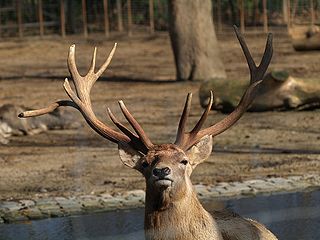
The Memorandum of Understanding (MoU) concerning Conservation and Restoration of the Bukhara Deer is a Multilateral Environmental Memorandum of Understanding and was concluded in 2002 under the auspices of the Convention on Migratory Species of Wild Animals (CMS), also known as the Bonn Convention, in collaboration with the Central Asia Programme of the World Wide Fund for Nature (WWF). The MoU covers five range States. As of August 2012, four of them had signed the MoU, as well as a number of cooperating organizations. The MoU came into effect on 16 May 2002.

The wild Bactrian camel is a critically endangered species of camel living in parts of northwestern China and southwestern Mongolia. It is closely related to the domestic Bactrian camel. Both are large, double-humped even-toed ungulates native to the steppes of central Asia. Until recently, wild Bactrian camels were thought to have descended from domesticated Bactrian camels that became feral after being released into the wild. However, genetic studies have established it as a separate species which diverged from the Bactrian camel about 1.1 million years ago.

















